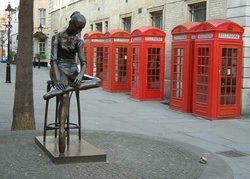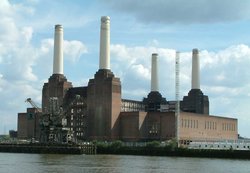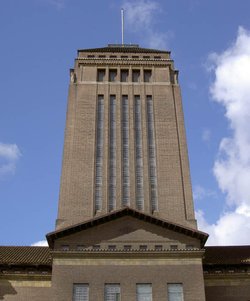Giles Gilbert Scott
|
|
Sir Giles Gilbert Scott (November 9, 1880—February 8, 1960) was an English architect known for his work on such buildings as Liverpool Cathedral and Battersea Power Station. He came from a family of famous architects, being the son of George Gilbert Scott Junior, grandson of Sir George Gilbert Scott, nephew of John Oldrid Scott and brother of Adrian Gilbert Scott. Scott was noted for his blending of Gothic tradition with modernism, making what might have been functionally designed buildings into popular landmarks.
| Contents |
Family
Scott was the third son of George Gilbert Scott junior. When he was three, his father was declared as of unsound mind and consequently Scott saw little of him: he claimed only to remember seeing him twice. A bequest from his uncle in 1889 gave him ownership of Hollis Street Farm, near Ninfield in Sussex, with a life tenancy to his mother; it was to here that his mother took him in order to escape the occasional violence of her husband.
Scott was sent to Beaumont College on the recommendation of his father, not because of any educational significance but because he admired the school buildings which were the work of J. F. Bentley. Scott spent his school holidays 'steeple-chasing' with his mother, which meant riding round Sussex on bicycles to look at interesting church architecture. The family were Roman Catholics.
Qualification as an architect
Scott's mother decided that her sons Giles and Adrian should become architects and he was articled to Temple Lushington Moore in 1899 for three years. Moore, who had been a pupil of Scott's father, actually worked at home while Scott worked in his office, which allowed Scott to develop his own architectural knowledge of his father's designs - which he regarded as the work of a genius, and superior to those of his grandfather (the latter judgment not shared by most architectural commentators).
Liverpool Cathedral
Scott is perhaps best known for his work on Liverpool Cathedral. When the competition for a 'Design for a twentieth century cathedral' was announced in 1902, he began work on the drawings at his home in Battersea in his spare time. He was surprised to be one of the five architects selected for the second round of the competition (his employer's designs were rejected) and even more surprised to win in 1903. The choice of Scott surprised others as well, because of Scott's youth (he was 22), lack of experience (he had designed a few private houses), and faith (as Liverpool was strongly divided between Anglicans and Roman Catholics).
Because of these factors, the Dean and Chapter decided that Scott should work together with George Frederick Bodley on the new Cathedral. However, they did not get on, with Scott complaining that Bodley had taken on too much other work. Scott was on the verge of resigning when Bodley suddenly died in 1907. This allowed him to continue single-handed and he immediately redesigned the Lady Chapel (one of the only parts then under construction) more in the style he favoured.
Liverpool_anglican_cathedral.jpg
In 1910 Scott realised that he was not happy with the main design which looked more like a traditional Gothic cathedral in the style originated in the previous century. He persuaded the cathedral committee to let him start all over again (a difficult decision, as some of the stonework had already been erected) and redesigned it as a simpler and more symmetrical building with a single massive central tower instead of the original proposal for twin towers.
With construction halted temporarily in the First World War and other delays, the building of the Cathedral lasted the whole of Scott's life and he remained involved in the project until his death, refining the design as he went. He designed every aspect of the building down to the fine details. With the choir and the first pair of transepts completed, the cathedral was consecrated in 1924. The tower was finished in 1942 but the first bay of the Nave was not completed until 1961 after Scott had died. The Cathedral was finished in 1980.
Other early work
While Scott was feuding with Bodley in Liverpool, he managed to design and see built his first complete church. This was the Church of the Annunciation, a Roman Catholic Church in Bournemouth, in which he made a high transept similar to that he wanted at Liverpool. His work on another new Roman Catholic Church at Sheringham, Norfolk showed his preference for simple Gothic frontages. Other churches built by Scott at this time at Ramsey on the Isle of Man, Northfleet in Kent and Stoneycroft in Liverpool show the development of his style. While working in Liverpool Scott met and married Louise Wallbank Hughes who was a receptionist at the Adelphi Hotel; Scott's mother was not pleased to learn that she was a Protestant.
During the First World War Scott was a Major in the Royal Marines. He was in charge of building sea defences in the English Channel.
Inter-war years
CropthorneCourt.jpg
As Liverpool Cathedral rose, Scott's fame rose too and he began to secure commissions for secular buildings. One of the first was for Clare Memorial Court, which was in a neo-Georgian style on the west bank of the River Cam. This style was also used for a house he designed for himself in Clarendon Place, Paddington in 1924. Scott rarely designed residential buildings but when he did, it could be successful as at the mansion block Cropthorne Court on Maida Vale in London where the frontage juts out in diagonals in order to reduce the need for lightwells.
By far Scott's most ubiquitous design was for the General Post Office. He was one of three architects invited by the Royal Fine Arts Commission to submit designs for new telephone kiosks. The invitation came at the time Scott was made a trustee of Sir John Soane's Museum and his design in the classical style but topped with a dome reminiscent of Soane won favour. It was put into production in cast iron as the GPO's 'Kiosk no. 2' or K2. Later designs adapted the same general look to other Kiosk types for mass-production: the Jubilee kiosk, introduced for King George V's silver jubilee in 1935 and known as the K6 eventually became a fixture in almost every town and village.
Signature buildings
The London Power Company had commissioned a new electricity generating station at Battersea and in 1930 commissioned Scott as a consultant to make the inevitably massive architecture more appealing. Scott chose external bricks and put some detailing on the sheer walls, then remodelled the four corner chimneys so that they resembled classical columns. Battersea Power Station, completed in 1933 but disused since 1982 remains one of the most conspicuous industrial buildings in London.
In Cambridge next to Clare Memorial Court, Scott designed a matching new Library for the University of Cambridge. He placed two six-storey courtyards in parallel with a twelve-storey squat tower in the centre, and linked the windows to the bookstacks vertically.
Professional recognition
The early 1930s were a time when Scott's reputation was the highest and he was chosen as President of the Royal Institute of British Architects for 1933, its centenary year. In his inaugural address he criticised both the diehard Traditionalist and the diehard modernist, calling for a 'middle line' in which architects accepted new methods of construction while seeking to always place the human element in architecture.
Scott's search for the 'middle line' caused him difficulties when he was appointed as architect for the new Coventry Cathedral in 1942. Pressured by the new Bishop of Coventry for a modern design and by the Royal Fine Arts Commission for a recreation of the old cathedral, he was criticised for trying to compromise between the two and designing a building that was neither fish nor fowl. Unable to reconcile these differences Scott resigned in 1947; a competition was later held and won by Sir Basil Spence with an uncompromisingly modern design.
After the House of Commons had been destroyed by bombs in 1941, Scott was appointed in 1944 to rebuild it. Here he was hemmed in entirely by the surviving building but was entirely of the view that the new chamber should be congruent with the old as anything else would clash with the Gothic style of Charles Barry and Augustus Pugin. This view found favour with Winston Churchill who observed "We shape our buildings; thereafter they shape us." In a debate on January 25, 1945 the House of Commons approved his choice by 121 to 21 on a free vote.
Late work
After the immediate rush for building work caused by war damage had died down, Scott put a new roof on the Guildhall in the City of London and designed modernistic brick offices just to the north for the Corporation. Despite having opposed placing heavily industrial buildings in the centre of cities, he accepted a commission to build Bankside power station on the banks of the River Thames in Southwark, where he built on what he had learnt at Battersea and gathered all the flues into a single tower. This building was converted in the late 1990s into Tate Modern art gallery.
Ourladyofmountcarmelkensington.jpg
Scott continued to receive commissions for religious buildings. At Preston he built a new Roman Catholic Church which is notable for an unusually long and repetitive Nave. His Carmelite Church in Kensington used transverse concrete arches to fill a difficult site (the church replaced another lost in the war).
Death
Scott remained working into his late 70s. He was working on designs for the Roman Catholic Church of Christ the King, Plymouth when he contracted Lung cancer, and took the designs into University College Hospital where he continued to revise them until his death on February 9, 1960.
Works
A comprehensive list of Gilbert Scott's designs:
- St. Botolph Church, Carlton-in-Cleveland, Yorkshire (1896 - 1897; Gilbert Scott did not design the church but was Clerk of the Works)
- Nanfans (private house), Prestwood, Buckinghamshire (1903)
- Liverpool Cathedral (design 1903, Scott continued to be associated with the building until his death)
- Chapel on London Road, Harrow, London (1905 - 1906)
- Church of the Annunciation (RC), Bournemouth (1906)
- Nave seating, All Saints Church, Bubwith, East Riding of Yorkshire (1909)
- East window, St. Giles Church, Burnby, East Riding of Yorkshire (1909)
- Our Lady Star of the Sea and St. Maughold Church (RC), Ramsey, Isle of Man, (1909 - 1912)
- Nave, St. Mary's Church, Bury (c. 1910)
- restoration of cloisters, including east window of the refectory and the Rood in the crossing at Chester Cathedral (1911 - 1913)
- Chancel of All Hallows Church, Gospel Oak (1913 - 1915)
- Church of Our Lady of the Assumption (RC), Northfleet, Kent (1913 - 1916)
- Lady Chapel Reredos, St. Michael's Church (RC), Elswick, Newcastle-upon-Tyne (1914)
- Rood Beam, St. Deiniol's Church, Hawarden, Flintshire (1915 - 1916)
- St. Paul's Church, Stoneycroft, Liverpool (1916) weblink (http://www.stpauls-stoneycroft.org)
- Chancel, St. Catherine's Church, Pontypridd (1919)
- War memorial, Hanmer, Flintshire (1919)
- War memorial, Hawarden, Flintshire (1919 - 1920)
- War memorial, St. Saviour's Church, Oxton, Birkenhead (1920)
- War memorial cross, Our Lady of Victories Church (RC), Clapham (1920)
Clarememorialcourt.jpg
- Alterations to south chancel chapel, Church of St. Mary Abbots Kensington (1920 - 1921)
- War Memorial Chapel, Church of St. Michael Chester Square, Belgravia (1920 - 1921)
- Rectory, War memorial tablet and northern aisle screen, Holy Trinity Church, Trefnant, Denbighshire (1921)
- New church, Ampleforth Abbey, Ampleforth, North Riding of Yorkshire (1922, not completed until 1961)
- Extensions to Junior House, Ampleforth College, Gilling, North Riding of Yorkshire (1920s - 1930s)
- Memorial Court, Clare College, Cambridge (1923 - 1934)
- Nave and monument to Abbot Ramsay, Downside Abbey, Somerset (c. 1923 - 1925)
- K2 Red telephone box (1924)
- Reconstruction of St. George's Church, Kidderminster (after 1924)
- War memorial, Preston (1925)
Chesterhousepaddington.jpg
- War memorial, All Saints Church, Wigan (1925)
- Church of St. Alban and St. Michael, Golders Green (1925, built 1932 - 1933)
- Chester House (private house), Clarendon Place, Paddington, London (1925 - 1926; his own home)
- Charterhouse School chapel, Godalming, the largest war memorial in England (1922; completed and consecrated 1927)
- All Saints Church, Wallasey (1927 - 1939, uncompleted)
- Church of St. Michael, Ashford, Surrey (1928; uncompleted)
- New Chapel, Bromsgrove School, Bromsgrove (1928 - 1939)
Whitelandsttc.jpg
- Continuation of the north range, St. Swithun's Buildings, Magdalen College, Oxford (1928 - 1930)
- St. Ninian's Church (RC), Restalrig, Edinburgh (1929; uncompleted)
- St. Francis of Assisi Church, High Wycombe (1929 - 1930)
- Whitelands Teacher Training College, Wandsworth (1929 - 1931)
- Plinth for statue of Sir Joshua Reynolds, Burlington House, Piccadilly (1929 / 1931)
- Battersea Power Station, London (consultant on exteriors 1929 - 1935)
- North East Tower, Our Lady of Grace and St. Edward Church (RC), Chiswick (1930)
- K3 Red telephone box (1930)
- Phoenix Theatre, off Charing Cross Road, London (1930 with Bertie Crewe)
- Altar, St. Augustine's Church, Kilburn Park Road, London (1930)
- St. Columba's Cathedral, Oban, Argyllshire 1930 - 1953)
- Cropthorne Court (private residences), Maida Vale (1930 / 1937)
- Apse and north tower, Church of Our Lady, Star of the Sea (RC), Broadstairs, Kent (1930 - 1931)
- Classroom range, Gilling Castle, Gilling, Yorkshire (after 1930)
- St. Andrew's Church, Luton (1931 - 1932)
- Chapel and college buildings, Lady Margaret Hall, Oxford (1931)
- New University Library, West Road, Cambridge (1931 - 1934)
Williamboothcollege.jpg
- William Booth Memorial Training College, Camberwell, south London (1932)
- Vincent House, Vincent Square, Westminster (1932; consultant)
- Clergy House for St. Francis of Assisi Church, High Wycombe (1933)
- Guinness Brewery, Park Royal, London (1933 - 1935)
- ventilator shaft buildings for the Mersey Tunnel (1934)
- Buildings in north court, Trinity Hall, Cambridge (1934)
- Font, Church of St. Michael Chester Square, Belgravia (1934)
- Additions to St. Joseph's Church (RC), Sheringham, Norfolk (1934)
- Restoration of St. Etheldreda's Church (RC), Ely Place, Holborn (1935)
22WeymouthStreet.jpg
- Fountains House, Park Lane, London (1935 - 1938; consultant)
- K6 Red telephone box (1935)
- Main Building, University of Southampton, Southampton (1935, in association with Gutteridge and Gutteridge)
- Private house, 22 Weymouth Street, St. Marylebone (1936)
- New Bodleian Library at Oxford (1937 - 1940)
- Alterations to barn at Denham Golf Club, Denham, Buckinghamshire (1938)
- St Anne's College, Oxford (1938)
- High pedestal for King George V monument, Old Palace Yard, Westminster (1939)
- North and South Blocks, County Hall, London (1939 and 1950 - 1958)
- Waterloo Bridge, London (1937 - 1940)
- Chamber of the House of Commons, Palace of Westminster (1945 - 1950)
- War memorial, St. John the Baptist Church, Penshurst, Kent (1947)
- Forth Road Bridge (1947; consultant)
- Bankside Power Station, London (1947, constructed 1957 - 1960) (now the Tate Modern art gallery)
- Extension to St Anne's College, Oxford (1949 - 1951)
- Power Station, Hoddesdon, Hertfordshire (c. 1952)
- St. Leonard's Church, St Leonards-on-Sea, Hastings (1953 - 1961 with his brother Adrian)
Guildhallnorthblock.jpg
- Roof for the bomb-damaged Guildhall, City of London (1953 - 1954)
- Extension at Clare Memorial Court, Clare College, Cambridge (1953 - 1955)
- Our Lady of Mount Carmel Church (RC), Kensington (1954 - 1959)
- St Anthony's Church (RC), Preston (1954 - 1959)
- Offices for the Corporation of London, Guildhall, City of London (1955 - 1958; alterations and refurbishment proposed)
- Chapel of Trinity College, University of Toronto, Canada (1955)
- North Tees Power Station, Billingham (1950s; demolished)
- St. Mark's Church, Biggin Hill (1957 - 1959)
- Church of Christ the King (RC), Plymouth (1961 - 1962; built posthumously)
Reference
- Gavin Stamp, 'Giles Gilbert Scott' in Oxford Dictionary of National Biography, Oxford University Press, 2004.
External link
- Biography (http://www.stpauls-stoneycroft.org/GGScott.htm)




